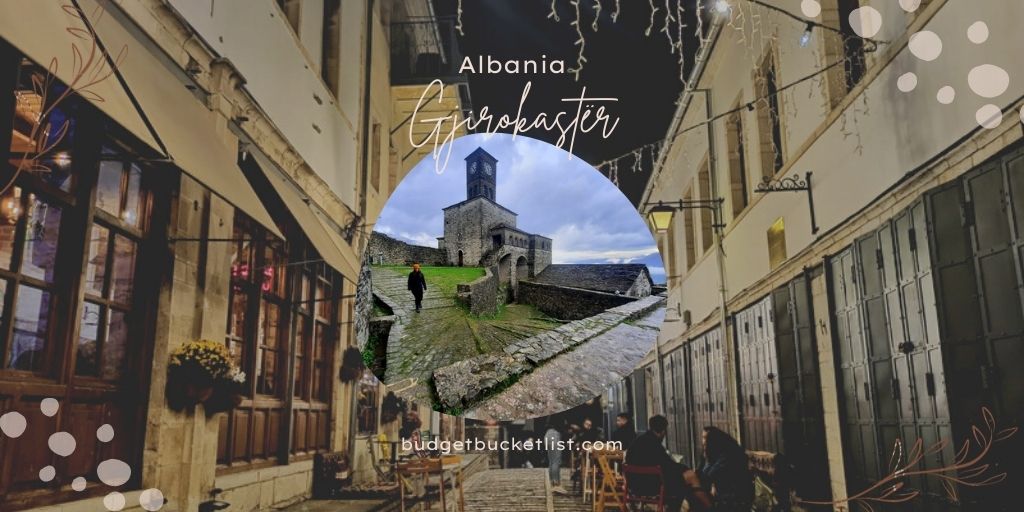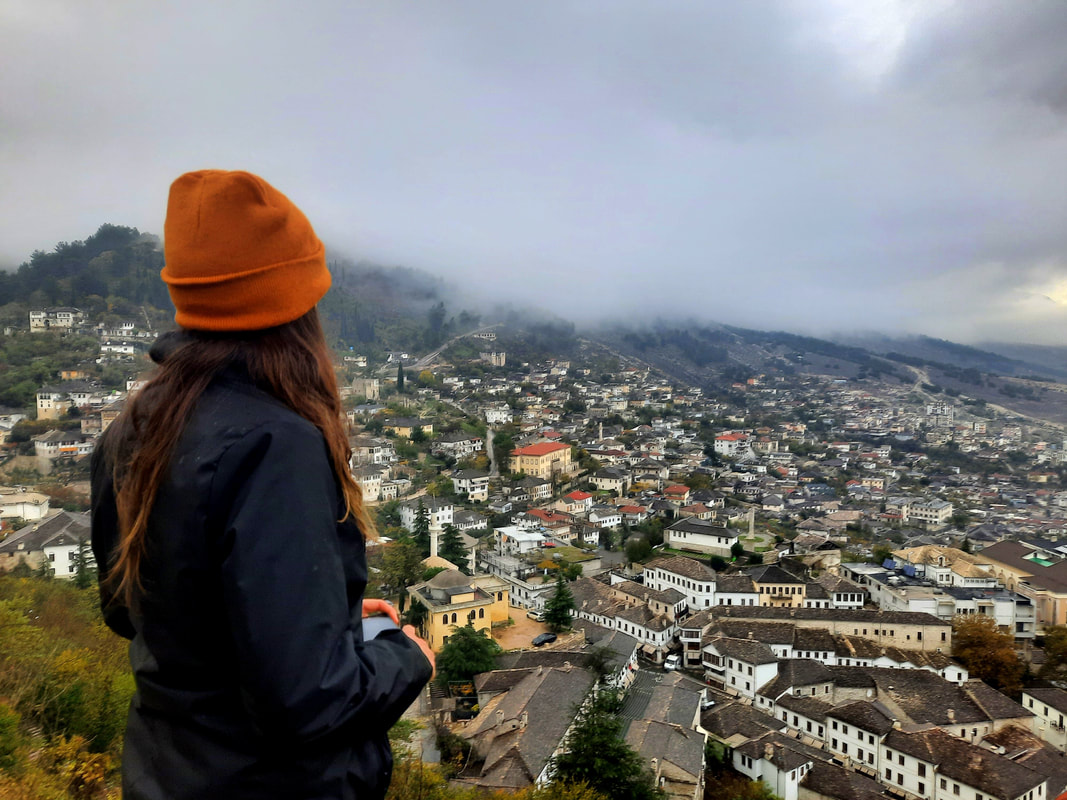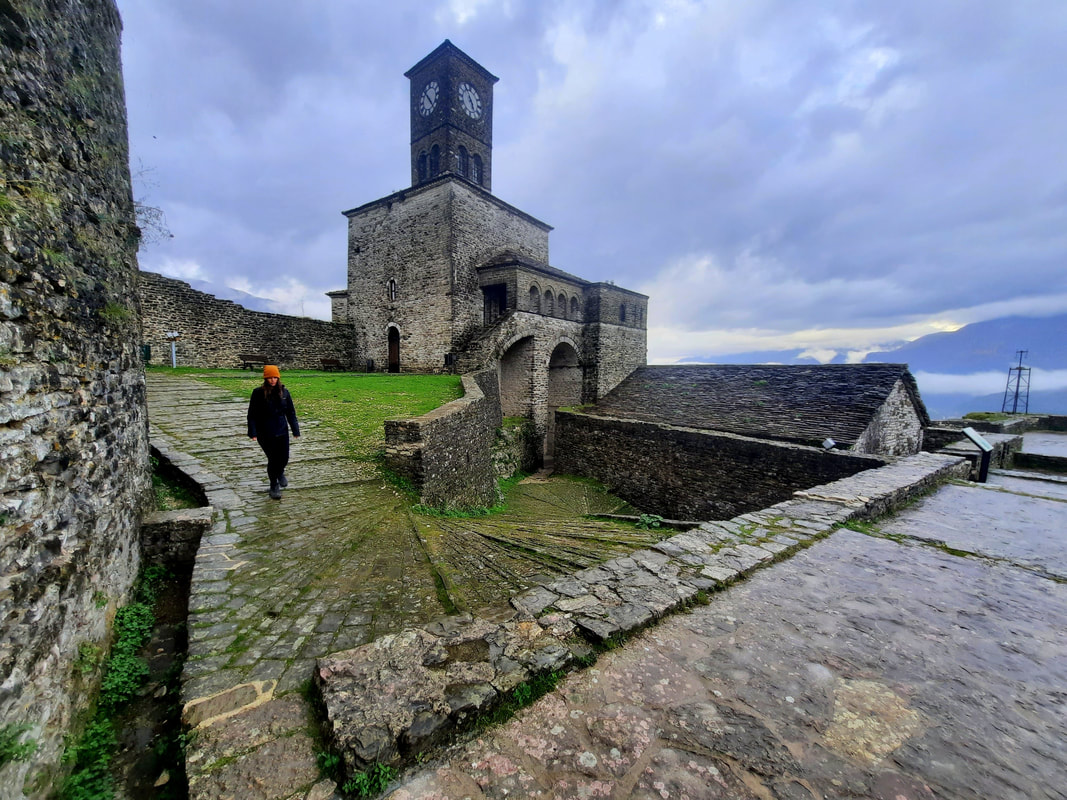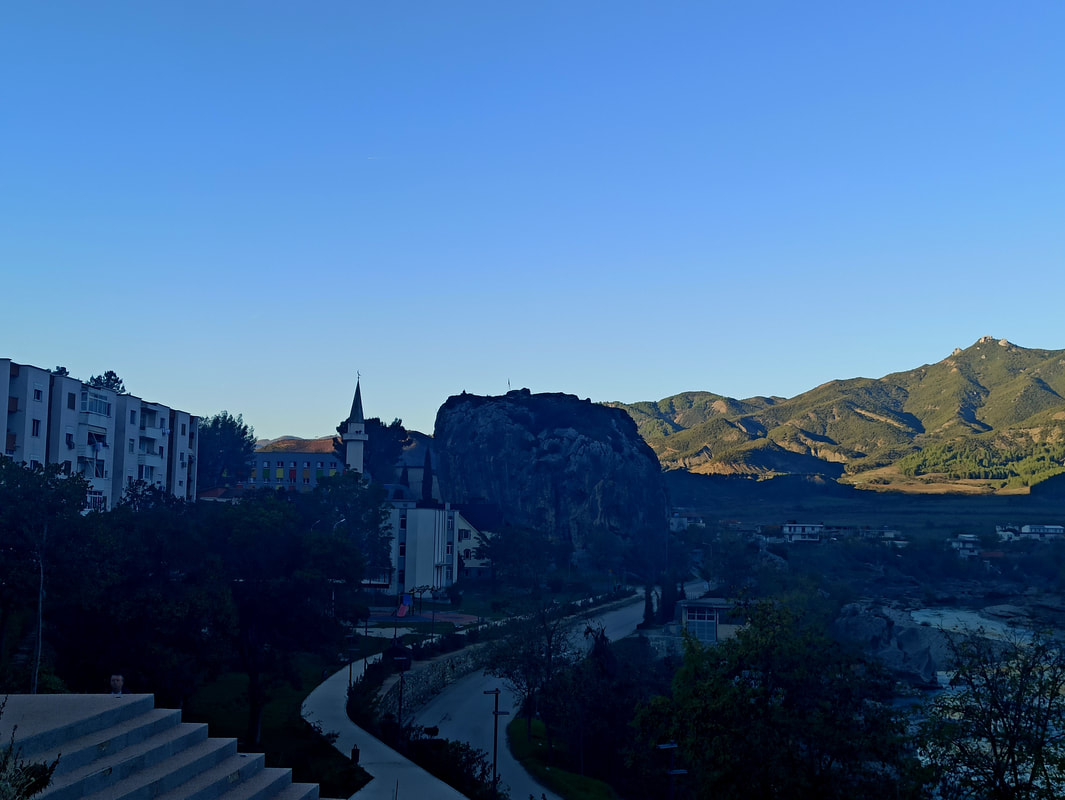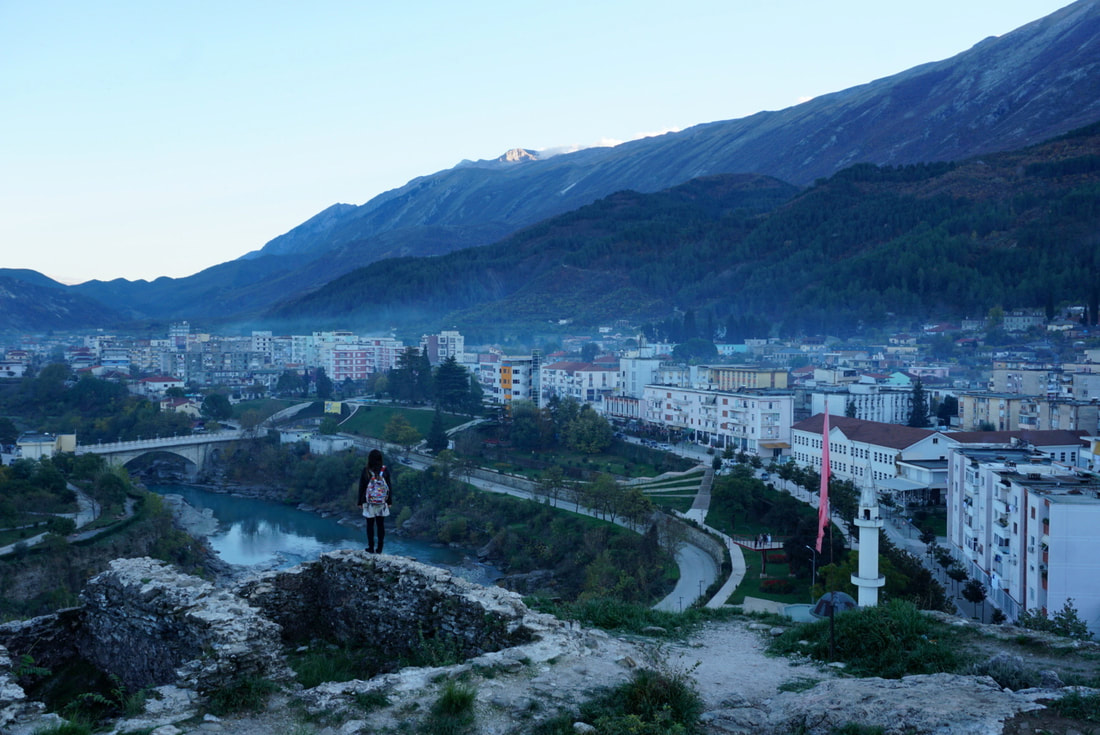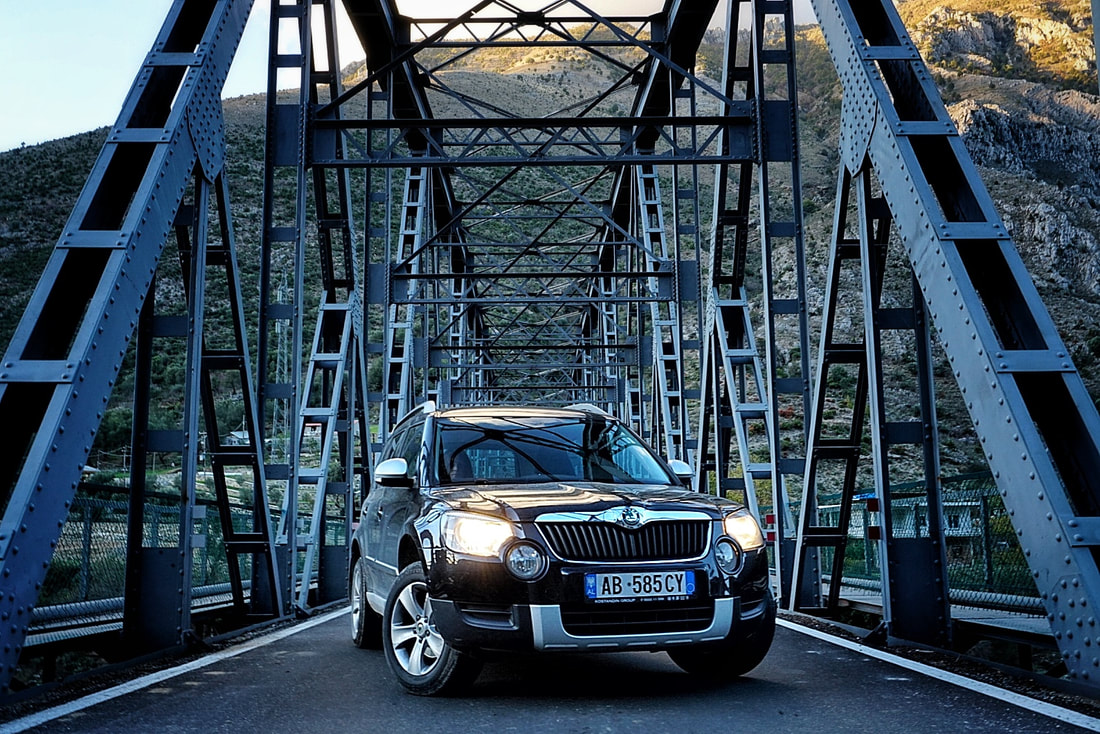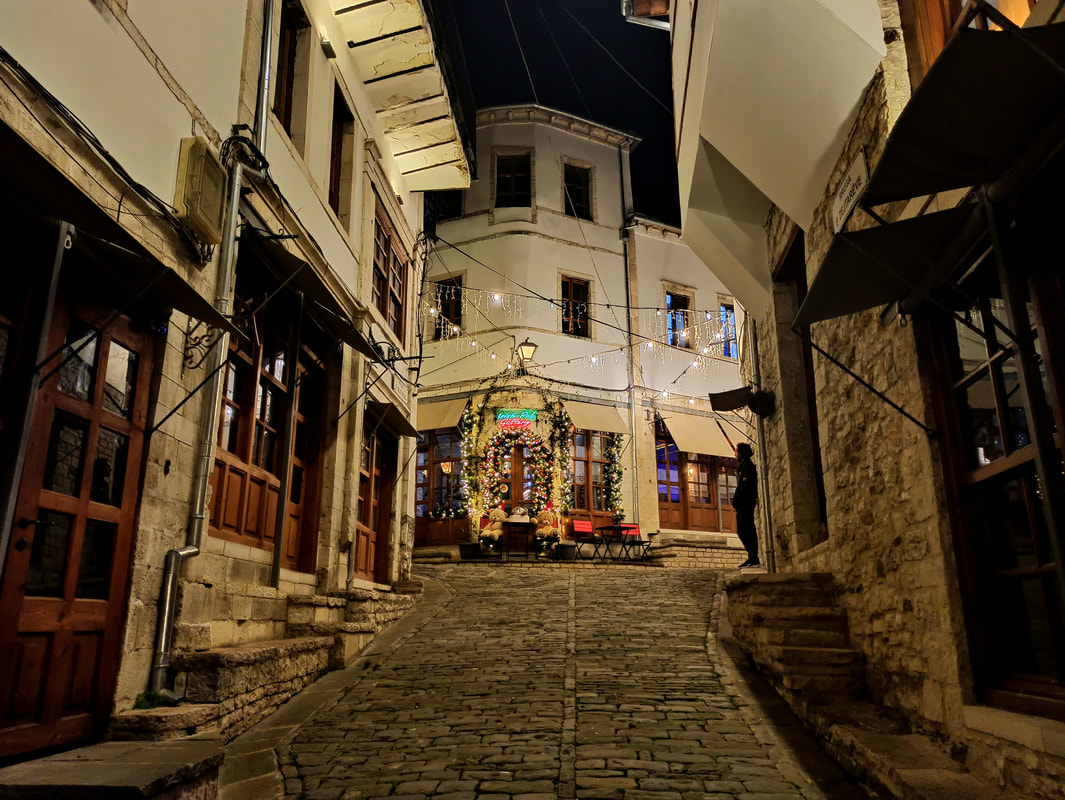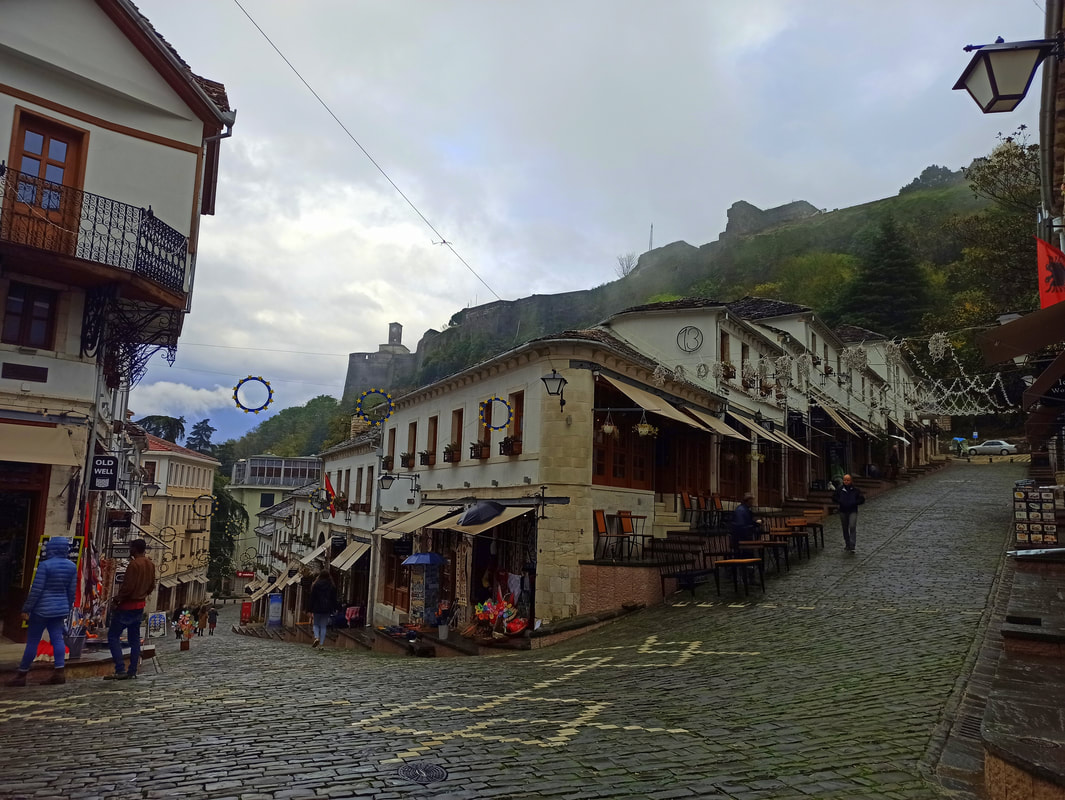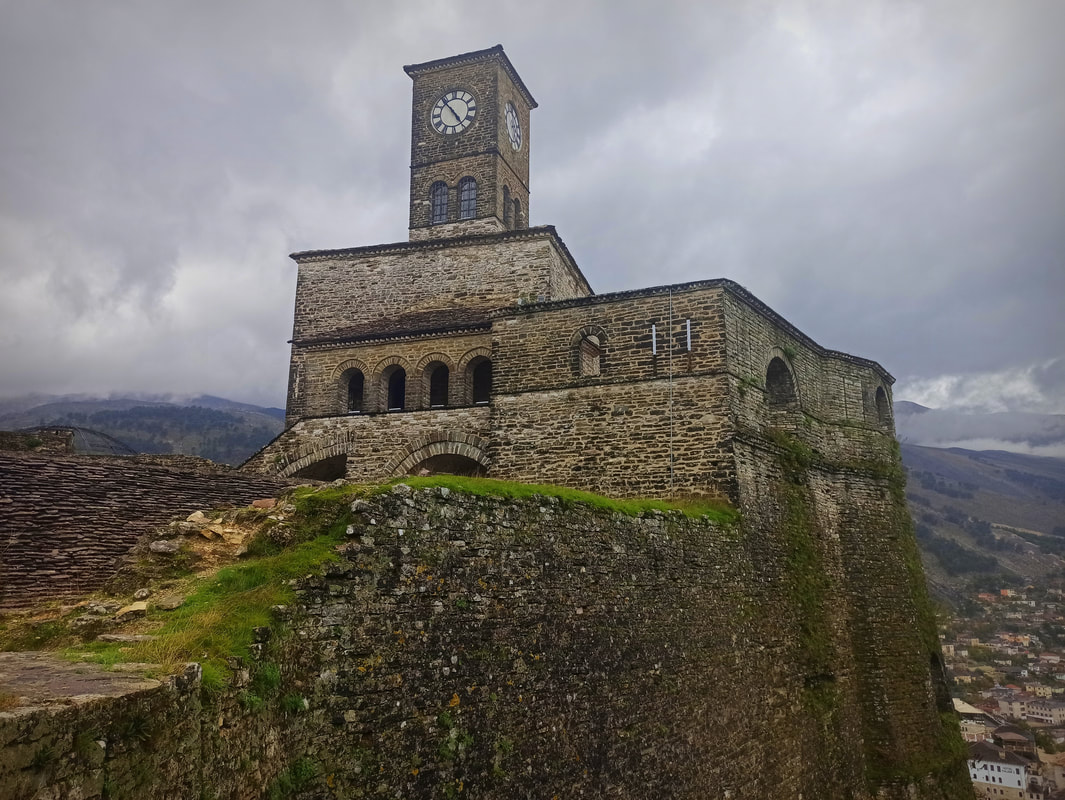Gjirokastër & Surroundings
Not in the story-mood? Scroll down for the Quick Budget Fact Overview: an itemized information summary of Gjirokastër! ↓
Some countries you enter with certain expectations. When it came to Albania, I had none. A country like Bosnia and Herzegovina is preceded by (sad) legends, the name “Montenegro” gives away its mountaineous character… but what’s one to expect with a country such as Albania? Yet, somehow when I entered Gjirokastër (Gjirokastra) it all made sense. This is what my subconscious previously decided Albania must be like. Its bustling bazar flawlessly blends the vivid colors of local folklore with the Ottoman heritage, its monuments and architecture aligning the steep streets effortlessly connect the past with the contemporary turmoil. An obvious UNESCO World Heritage Site. The national cultural capital, décor of the childhoods of the country’s heroes and fiends… including Ottoman leader Ali Pasha, novelist Musine Kokalari* and ruthless Stalinist leader Enver Hoxha, who implemented a brutal local genocide and put Albania in a 4-decade lockdown. The history of Gjirokastër determines the face of today’s Albania.
* She was the first published female writer in Albania, writing in her native Gjirokastrian dialect.
* She was the first published female writer in Albania, writing in her native Gjirokastrian dialect.
Too busy to read now? No problem, save it for later!
Save on Get Pocket | Save in Browser Bookmarks| Save on Instapaper
Save on Get Pocket | Save in Browser Bookmarks| Save on Instapaper
Why Should I Go?
If the intro didn’t already give away the city’s historical and cultural significance, I honestly don’t know what does. Just being here feels special. That said, it’s more interesting to turn such a feeling into concrete activities, which can easily fill a day in this tiny but dynamic little town on the hilltop.
Your first stop will undoubtedly be the Gjirokastër Castle. I know, I know… If you have been traveling the Balkans for quite a bit already, odds are high you’re properly over those damned castles already. I sure as hell know I was. But hear me out, this place truly is something else. Not only is it one of the biggest castles I have seen in the entire Balkan-region (together with the Rozafa Castle in Shkodër), it’s the best preserved and restored one. Not to mention with one of the best views. When you slowly wander in between the castle walls you can effortlessly relive its turbulent history, both real and mythical. Talking of the latter: According to local legends, the Albanian Princess Argjiro refused to surrender when the Ottomans came knocking at the door during the 15th century. When she threw herself and her baby off the castle walls, the child miraculously survived… and where his mother fell to her inevitable death, milk flowed from the rocks. A magical tale backed up by some actual geological evidence: At the foot of the castle walls, limestone cliffs are covered in calcium deposits.
If the intro didn’t already give away the city’s historical and cultural significance, I honestly don’t know what does. Just being here feels special. That said, it’s more interesting to turn such a feeling into concrete activities, which can easily fill a day in this tiny but dynamic little town on the hilltop.
Your first stop will undoubtedly be the Gjirokastër Castle. I know, I know… If you have been traveling the Balkans for quite a bit already, odds are high you’re properly over those damned castles already. I sure as hell know I was. But hear me out, this place truly is something else. Not only is it one of the biggest castles I have seen in the entire Balkan-region (together with the Rozafa Castle in Shkodër), it’s the best preserved and restored one. Not to mention with one of the best views. When you slowly wander in between the castle walls you can effortlessly relive its turbulent history, both real and mythical. Talking of the latter: According to local legends, the Albanian Princess Argjiro refused to surrender when the Ottomans came knocking at the door during the 15th century. When she threw herself and her baby off the castle walls, the child miraculously survived… and where his mother fell to her inevitable death, milk flowed from the rocks. A magical tale backed up by some actual geological evidence: At the foot of the castle walls, limestone cliffs are covered in calcium deposits.
The two previous photos by Miles Watson Photography. Undoubtedly the best time to visit the Gjirokastër Castle is when the National Folk Festival is on (organized since 1968).
The castle houses two museums requiring an additional entry fee: the Arms Museum and Gjirokastër Museum. Especially the latter sheds an interesting light on the city’s past events and the lives of the (in)famous citizens it brought forth. Other museums include the Ethnographic Museum, Skenduli House and Zekate House – I’d say, pick one outta’ three to get the global idea.
To travel even further back in time, you can make the short drive to the archaeological remains of Hadrianopolis (later named Justinianopolis) and Antigonea. The latter flourished from the 4th - 2nd centuries BC and was allied to the Kingdom of Macedonia in its wars against the Romans. Following the defeat of King Philip V of Macedonia in 168 BC, consul Aemilius Paullus ordered the destruction of the city. The Romans set all buildings on fire, demolished the walls and sold the inhabitants into slavery. Modern excavations exposed a thick layer of ash all over the city… serving as evidence of the violence of the destruction.
The castle houses two museums requiring an additional entry fee: the Arms Museum and Gjirokastër Museum. Especially the latter sheds an interesting light on the city’s past events and the lives of the (in)famous citizens it brought forth. Other museums include the Ethnographic Museum, Skenduli House and Zekate House – I’d say, pick one outta’ three to get the global idea.
To travel even further back in time, you can make the short drive to the archaeological remains of Hadrianopolis (later named Justinianopolis) and Antigonea. The latter flourished from the 4th - 2nd centuries BC and was allied to the Kingdom of Macedonia in its wars against the Romans. Following the defeat of King Philip V of Macedonia in 168 BC, consul Aemilius Paullus ordered the destruction of the city. The Romans set all buildings on fire, demolished the walls and sold the inhabitants into slavery. Modern excavations exposed a thick layer of ash all over the city… serving as evidence of the violence of the destruction.
What’s Around?
For a more natural experience you have to leave Gjirokastër, without needing to go too far. Permët is as a city far less impressive, but it’s rubbing shoulders with the alluring Fir of Hotova National Park. The park is with 343.61 km2 the largest one of Albania and – as the name suggests – covered in hotova fir trees. Hiking this area will lead you through dense forests, lime- and sandstone deposits, gorges and canyons cut in half by swirling rivers, and exuberant valleys. When it comes to the local fauna, the brown bears, wolves, foxes, martens, wild boars and roe deer are most prominent.
A variety of hiking trails can be found here.
Permët has an interesting natural sight of its own: the City Stone. Marked a cultural, natural and archaeological monument, the oddly shaped 25-meter tall rock looks like it comes straight out of a Harry Potter movie. Randomly plunged right in the middle of town (or more likely the other way around), it makes for both an eyebrow-raising landmark and a sublime look-out point when climbed. Don’t forget to notice the remains of a medieval fortress on top… what a spot for it! Not unlike the Princess Argjiro story of Gjirokastër, Permët recounts the heroic suicide-tale of local ruler Premt, who likewise preferred death over surrendering to the Ottomans. Together with his daughter Aleksandra he fiercely jumped off the City Stone, collapsing into the Vjosa River… after which Permët was named after him.
For a more natural experience you have to leave Gjirokastër, without needing to go too far. Permët is as a city far less impressive, but it’s rubbing shoulders with the alluring Fir of Hotova National Park. The park is with 343.61 km2 the largest one of Albania and – as the name suggests – covered in hotova fir trees. Hiking this area will lead you through dense forests, lime- and sandstone deposits, gorges and canyons cut in half by swirling rivers, and exuberant valleys. When it comes to the local fauna, the brown bears, wolves, foxes, martens, wild boars and roe deer are most prominent.
A variety of hiking trails can be found here.
Permët has an interesting natural sight of its own: the City Stone. Marked a cultural, natural and archaeological monument, the oddly shaped 25-meter tall rock looks like it comes straight out of a Harry Potter movie. Randomly plunged right in the middle of town (or more likely the other way around), it makes for both an eyebrow-raising landmark and a sublime look-out point when climbed. Don’t forget to notice the remains of a medieval fortress on top… what a spot for it! Not unlike the Princess Argjiro story of Gjirokastër, Permët recounts the heroic suicide-tale of local ruler Premt, who likewise preferred death over surrendering to the Ottomans. Together with his daughter Aleksandra he fiercely jumped off the City Stone, collapsing into the Vjosa River… after which Permët was named after him.
In order to easily reach the national parks and archaeological sites surrounding Gjirokastër, a rental car is highly recommended. In low season local public transport can be severely limited, especially to the more remote locations mentioned in this article. Having your own vehicle allows for a more thorough and true exploration of Albania, going beyond the standard tourist stops. You owe this to yourself! I had a great experience with Rental Shkodra, who provided me with a reliable vehicle and 24/7 customer service. I can’t recommend them enough!
Photo by Miles Watson Photography.
Quick Budget Fact Overview
Albania Facts
History Recap
1000BC: Illyrians (Indo-European tribesmen). Country name from an Illyrian tribe: Arber / Albanoi. 165BC: Illyria under control Romans. 44BC: Caesar began building a colony at Butrint. 1-100: Christianity. 300-700: Goths, Huns, Avars, Serbs, Croats, and Bulgars successively invade Illyrian lands. 395: Division of Roman Empire à present-day Albania under Eastern Byzantine Empire. 700-800: Slav tribes settle. 1054: Roman and Orthodox Churches split (Orthodox don’t accept papal authority Rome). 1100-1200: Serbs occupied parts of Albania. 1204: Venice won control over most of Albania, but Byzantines regained control of south. 1385: Albanian ruler invited Ottoman forces to intervene against a rival in Battle of Savra. Start of slow expansion Ottoman Rule. 1403: Gjergj Kastrioti born: Albanian hero known as Skanderbeg who organized resistance to Ottomans in Krujë (repulsed 12 invasions) and kept Albania independent for 20+ years. ’68: Skanderbeg died and the Turks absorbed Albania into the Ottoman Empire. Conversion to Islam. 1614: Ottoman general Sulayman Pasha named Tehran (later Tirana) as the capital, after Iran’s. 1822: Albanian leader Ali Pasha was assassinated by Ottomans for promoting autonomy. ’61: First school known to use Albanian language opened in Shkodër. ‘78: Treaty of San Stefano / Treaty of Berlin: Ending Russo-Turkish War (Ottoman Empire lost numerous territories) & Divided Balkans among European powers. 1910: Mother Teresa born to an ethnic Albanian family in Skopje, Macedonia. ’12: First Balkan War (Balkan countries against Ottomans). Nov 28: Independence of Albania declared. ‘13: End First Balkan War with Treaty of London, beginning of Second Balkan War. Albania recognized as independent state: Demographics were ignored, half Albanian inhabited territories divided among Montenegro, Serbia and Greece. 1914-’18: WWI - Italian occupation. ’28: Albania kingdom under Zogu / parliament dissolved.’37: Italian occupation. ’39: WWII: Italian invasion and annexation (King Zogu fled to Greece). ‘41: Enver Hoxha becomes head of new Communist Party. ’43: German forces invade à ’44: withdraw after Communist resistance. Hoxha new leader: Brutal Stalinist rule for 40 years, mass murders, people being unable to enter or exit Albania. SU and China ties broken over ideologist ideas.’67: Limitation religious activity; Albania declared world's first atheist state. ’85: Hoxha dies. ’89: Communist rule in Eastern Europe collapses. ’90: Albanians granted right to travel abroad. Many flee. ’98: Kosovaran refugee exodus into Albania. ’03: First talks towards EU membership. ’09: Joins NATO and formally applies for EU membership --> rejected in ’10.
Albania Facts
- Capital: Tirana (Tiranë)
- Population: ± 2.8 mln (Gjirokastër: 20,000)
- Language: Albanian
- Sq km: ± 28.748 (Gjirokastër: 469.2)
- Currency: Lek (ALL - L)
- Electricity Outlet: C /F /E, 230v, 50Hz (standard European – check here)
- Country Code Phone: +355 84
- Emergency Phone: 112 (general), 127 (ambulance), 128 (fire), 112 (police)
- Visa: Check out the visa requirements here
- Vaccinations: Covid / Hep-A / Hep-B / Routine Vaccines
- Climate: Warm-Summer Mediterranean (Csb)
- High season: April – October
History Recap
1000BC: Illyrians (Indo-European tribesmen). Country name from an Illyrian tribe: Arber / Albanoi. 165BC: Illyria under control Romans. 44BC: Caesar began building a colony at Butrint. 1-100: Christianity. 300-700: Goths, Huns, Avars, Serbs, Croats, and Bulgars successively invade Illyrian lands. 395: Division of Roman Empire à present-day Albania under Eastern Byzantine Empire. 700-800: Slav tribes settle. 1054: Roman and Orthodox Churches split (Orthodox don’t accept papal authority Rome). 1100-1200: Serbs occupied parts of Albania. 1204: Venice won control over most of Albania, but Byzantines regained control of south. 1385: Albanian ruler invited Ottoman forces to intervene against a rival in Battle of Savra. Start of slow expansion Ottoman Rule. 1403: Gjergj Kastrioti born: Albanian hero known as Skanderbeg who organized resistance to Ottomans in Krujë (repulsed 12 invasions) and kept Albania independent for 20+ years. ’68: Skanderbeg died and the Turks absorbed Albania into the Ottoman Empire. Conversion to Islam. 1614: Ottoman general Sulayman Pasha named Tehran (later Tirana) as the capital, after Iran’s. 1822: Albanian leader Ali Pasha was assassinated by Ottomans for promoting autonomy. ’61: First school known to use Albanian language opened in Shkodër. ‘78: Treaty of San Stefano / Treaty of Berlin: Ending Russo-Turkish War (Ottoman Empire lost numerous territories) & Divided Balkans among European powers. 1910: Mother Teresa born to an ethnic Albanian family in Skopje, Macedonia. ’12: First Balkan War (Balkan countries against Ottomans). Nov 28: Independence of Albania declared. ‘13: End First Balkan War with Treaty of London, beginning of Second Balkan War. Albania recognized as independent state: Demographics were ignored, half Albanian inhabited territories divided among Montenegro, Serbia and Greece. 1914-’18: WWI - Italian occupation. ’28: Albania kingdom under Zogu / parliament dissolved.’37: Italian occupation. ’39: WWII: Italian invasion and annexation (King Zogu fled to Greece). ‘41: Enver Hoxha becomes head of new Communist Party. ’43: German forces invade à ’44: withdraw after Communist resistance. Hoxha new leader: Brutal Stalinist rule for 40 years, mass murders, people being unable to enter or exit Albania. SU and China ties broken over ideologist ideas.’67: Limitation religious activity; Albania declared world's first atheist state. ’85: Hoxha dies. ’89: Communist rule in Eastern Europe collapses. ’90: Albanians granted right to travel abroad. Many flee. ’98: Kosovaran refugee exodus into Albania. ’03: First talks towards EU membership. ’09: Joins NATO and formally applies for EU membership --> rejected in ’10.
FREE Recommended Sights / Activities*
PAID Recommended Sights / Activities*
* A relatively complete overview of all sights and activities can be found on TripAdvisor… these lists include the ones I personally recommend.
Evening Entertainment
Local Festivals
- Sights: UNESCO Old Town / Bazaar.
- Hikes / Nature: Zagoria Nature Park; Fir of Hotova National Park (next to Permët).
PAID Recommended Sights / Activities*
- Sights: Gjirokastër Castle; Cold War Tunnel (closed during my time of visit- November); Antigonea Archaeological Park.
- Museums: Arms Museum & Gjirokastër Museum (inside the castle with separate fee); Ethnographic Museum; Skenduli House; Zekate House.
* A relatively complete overview of all sights and activities can be found on TripAdvisor… these lists include the ones I personally recommend.
Evening Entertainment
- Nightlife Areas: Old Town.
Local Festivals
- Carnival – February.
- Gjiro Open Air Fest (paragliding) - March.
- Gjirokastër National Folklore Festival – May.
- Sofat Festival, Libohova / Nivica / Tepelena – September.
Budget Bites
Sleep Cheap
- Bigger Supermarkets: Spar, Star, Big, Bebej, Top, Peçi.
- Local Dishes: Fërgesë (stew); Byrek (stuffed pastry); Tavë Kosi (baked lamb/chicken in yoghurt); Kackavall Në Furrë Me Domate (baked cheese with tomatoes); Speca Me Gjize (cheese-stuffed bell peppers); Speca te Mbushur me Oriz (stuffed bellpeppers with rice); Gjel Deti me Përshesh (baked turkey with bread mash); Peshk Dhe Pherime Ne Tave (fish and veg); Flija (baked crepes); Jani Me Fasule (white bean soup); Qofte (lamb meat balls); Tave Mishi (mixed grill); Sarme (cabbage rolls stuffed with rice and meat); Qifqi (fried rice balls); Pispili (cornbread with leek); Trilece (cake); Ashure (dessert); Petulla (fried dough). Gjirokastër is famous for Pashaqofte (soup with meatballs), Qifqi, Shapkat (spinach corn pie casserole), Sarma (stuffed grape leaves) and Qahi (tiny spinach pies).
- The Veg Situation: Going vegetarian is rather easy in Albania, but going vegan is next to impossible as milk / egg is in all that remains. There are luckily quite some local vegetarian dishes, some already explained above. Local veg dishes: Fërgesë Verorë (summer version); Byrek (choose cheese or spinach); Kackavall Në Furrë Me Domate; Speca Me Gjize; Speca te Mbushur me Oriz; Flija; Jani Me Fasule; Tave Mishi (vegan); Jufka (pasta cooked in butter); Ima lam Bajalldi (eggplant cooked in oven - vegan); Turli (vegetables stew - vegan); Tarator (cold soup); Salce Kosi (yoghurt sauce); Qifqi; Pispili; Trilece; Ashure; Petulla.
- National Drink: Rakia. Some local beer brands include Birra Korca, Bira Tirana and Birra Stela. Albania has wine production, but not as prominent as in Montenegro or Macedonia.
Sleep Cheap
- Hostels / Hotels: are relatively cheap in Albania compared to the rest of Europe, although more expensive than in other Balkan countries such as Montenegro, Bosnia and Herzegovina and Serbia. I personally found the best deals on Booking.com, which is generally cheaper than Air BnB listings here. If you use it often enough, Genius-discounts are applied. A nuisance in Albania is that once you booked, that doesn’t necessarily mean it’s actually confirmed: In my case, often the booking was immediately denied by the owner (or you’re not informed at all and show up in front of a closed door): Always call/email to confirm 100%. Payment generally happens on-site in cash. Writer’s choice: I went to Gjirokastër twice, and both accommodations I stayed in I don’t recommend. The rooms at Camping Late were not so clean and the roof leaked (cheap though, with breakfast incl.). Guesthouse Garden had a central location and the rooms were alright, but the friendliness of service was so-so and I found sperm-spots on the sheets. Yes, really.
- Couchsurfing: allows you to stay with locals. Nowadays it has a moderate sign-up cost (unless you put a third-world country as homebase), but paying extra for verification is unnecessary: Positive reviews are way more important. Once active, there are no costs for staying at someone’s house. In order to get accepted, make sure to write an elaborate review explaining why you applied to this specific profile and think you and your potential host are a good match (copy-pastes tend to be ignored).
- Housesitting: is an amazing exchange allowing you to stay short- or long-term in somebody’s house, while looking after their property and pets. There are many different websites, most of them paid, the main one being Trusted Housesitters… but once you landed a sit, the subscription fee pays itself back quickly. ‘
Photo by Miles Watson Photography.
Mama Said
Transport
Next?
Mama Said
- Safety: Don’t believe the gossip of people who never actually been here: Albania is safe! Crime rates are low and the level of hospitality is heart-warming. People go out of their way to make you feel welcome and assist you in any way they can. Of course, like everywhere in the world, use your common sense: Don’t walk alone in remote areas after sunset, don’t take valuables along etc.
- Tap Water: is drinkable.
- There are no ATM’s and supermarkets in Theth (besides a tiny overpriced mini-market) and paying by card isn’t generally accepted. Cash out and shop in Koplik or Shkodër.
- The only bank that doesn’t charge an ATM fee is Credins Bank.
- Don’t speak Albanian? Your Italian language skills might help! Due to long, recent occupation periods by Italians (check the History Recap) many Albanians speak some basic Italian.
Transport
- Walking: Everything in Gjirokastër is at walking distance. Mind you: it’s very steep!
- Cycling: Unless you have legs of steel and don’t mind cycling uphill, I wouldn’t necessarily qualify Gjirokastër as a very bicycle-friendly town.
- City Buses / Tram / Metro: There are some city buses, but navigation tools such as Google Maps and Moovit don’t work here for public transport options. For schedules (as far as there are some) and directions you’ll have to ask around at the spot where you are standing.
- Taxi / Uber: Taxis can be hailed down on the street and are affordable. Negotiate the price in advance, or asked to have the meter turned on.
- Intercity Buses: Bus schedules vary constantly (per season and per day) and online info is unreliable, so I recommend buying bus tickets a day in advance at the bus station or private ticket office to be certain of the available departure times. Keep in mind that there isn’t one main bus station in Gjirokastër, but depending on your destination you either have to google the location on Bulevardi 18 Shtatori or the main road SH4 / E853. International buses to Greece (Ioannina) go generally once a day.
- Train: Not available.
- Car Rental: Rental Shkodra is strongly recommended. The roads to Gjirokastër are of decent quality.
- Airport: Tirana International Airport (TIA).
- Hitchhiking: is relatively safe in Albania, and especially in the countryside you can see even locals doing it. It’s easy at Gjirokastër, as there is only one main road (SH4 / E853). However, it’s common practice to offer payment, so verify this before getting into the car to avoid awkward situations. Take into account that English is not widely spoken (Italian is!), so chit-chat might be complicated.
Next?
- National Destinations Close By: Permët, Sarandë, Ksamil, Himarë, Çorovoda, Berat, Korçë.
- International Destinations Close By: Macedonia, Kosovo, Montenegro, Greece, Italy.
In order to support the travelers’ community, I spend many hours per week to adequately document all information and advices for prospective visitors, accompanied by a (hopefully) entertaining insight into my personal observations and experiences. This service is and will remain free. However, if you voluntarily want to make a contribution and support my travels and thus the creation of new stories and information supply, here is the button you’re looking for:
Related:
- Get your Albania itinerary ready: Berat, Gjirokastër, Korcë / Ohrid Lake, Theth, Shkodër, Tirana, Mount Korab & the coast!
- Check out Budget Bucket List's FAVORITE HIKING DESTINATIONS worldwide!
- Visit Balkan's finest: Montenegro's National Parks Blog, Kotor Bay & Lovcen NP and Cetinje, Podgorica, Prokletije NP and Montenegro's Coastal Towns Blog
- 10 typical Dutch celebrations no traveller should miss out on
- History preserved: Time capsule of Romanian culture Maramures
- Get deep into Greece: Athens, Delphi, Arachova, Mount Parnassos NP, Epirus, Meteora, Thessaloniki & Volos
- Archeological treasures, UNESCO sights and Greece's roughest nature: Explore the Peloponnese!
- Be about Bulgaria: Check off Bansko, Belogradchik, Plovdiv, Sofia and of course Veliko Tarnovo!
- Where modern meets classic: Vilnius, Lithuania
- 8 ways to save money in Vienna, Austria
- German gems: Aachen & Frankfurt am Main
- Europe's best skiing & hiking: Get your ass over to jaw-dropping Switzerland!
- Budget Bucket List hitchhike trip to... Kosovo!
- Destinations of Hungary: Balaton Lake, Budapest and Szekesfehervar
- Unravel the mysteries of Serbia
- Discover the splendours of Turkey: Istanbul on a Budget & Reasons to visit Edirne
- Get your Albania itinerary ready: Berat, Gjirokastër, Korcë / Ohrid Lake, Theth, Shkodër, Tirana, Mount Korab & the coast!
- Check out Budget Bucket List's FAVORITE HIKING DESTINATIONS worldwide!
- Visit Balkan's finest: Montenegro's National Parks Blog, Kotor Bay & Lovcen NP and Cetinje, Podgorica, Prokletije NP and Montenegro's Coastal Towns Blog
- 10 typical Dutch celebrations no traveller should miss out on
- History preserved: Time capsule of Romanian culture Maramures
- Get deep into Greece: Athens, Delphi, Arachova, Mount Parnassos NP, Epirus, Meteora, Thessaloniki & Volos
- Archeological treasures, UNESCO sights and Greece's roughest nature: Explore the Peloponnese!
- Be about Bulgaria: Check off Bansko, Belogradchik, Plovdiv, Sofia and of course Veliko Tarnovo!
- Where modern meets classic: Vilnius, Lithuania
- 8 ways to save money in Vienna, Austria
- German gems: Aachen & Frankfurt am Main
- Europe's best skiing & hiking: Get your ass over to jaw-dropping Switzerland!
- Budget Bucket List hitchhike trip to... Kosovo!
- Destinations of Hungary: Balaton Lake, Budapest and Szekesfehervar
- Unravel the mysteries of Serbia
- Discover the splendours of Turkey: Istanbul on a Budget & Reasons to visit Edirne
